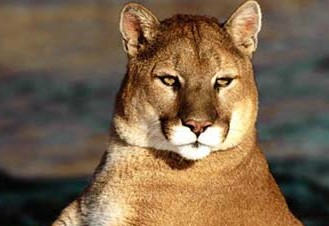The biggest cougars are found in the Southern Interior of B.C. including the Kootenays, the average weight for males is between 63 and 90 kg (138 to 198 lbs), and for females between 40 to 50 kg (88 to 110 lbs), they can measure over 2 meters (including the tail).
There are three sub-species of cougar in B.C. with different coat colours: a darker coat on the West Coast, reddish coat on Vancouver Island, and a lighter coat in the interior. They have a fairly uniform colour without stripes or spots, however the cougar kittens are spotted with dark brown spots over a brown buff coat. The spots gradually fade during the first year
FACTS
Cougar attacks are very rare, in the past 100 years 5 persons have died of cougar attacks in British Columbia (4 of those fatal attacks happened on Vancouver Island). Cougars would rather avoid humans and most serious attacks are attributed to old starving cougars or to a females cougars defending their young.
Cougars have been spotted displaying a harmless curiosity toward people: they have been observed sitting at a vantage point and watching, sometimes for hours, people working or playing outdoors. Some people have even reported the tracks of a cougar following their own in the snow.
Cougars are able to kill animals heavier than themselves such as deer or young moose; they are very secretive, unpredictable and mysterious.
Cougars are more inclined to attack children than adults; the hypothesis being that children have a high-pitched voice, a small size and move quickly, which makes them hard to distinguish between threat and prey to a cougar.
As carnivores, their eating habits include wild sheep, elk, moose, deer, rabbits, beaver, raccoons, grouse, birds and occasionally livestock. They are active mainly at night from dusk to dawn, and they hunt primarily by sight and sound.
Females give birth to one to six kittens every 18 to 24 months, kittens become independent at one or two years of age.
NATURAL HABITAT
Cougars are found in a wide variety of habitats: through mountains, forests, steppes, grasslands and semi-desert, mostly in the southern third of B.C. and northern part of Vancouver Island; their habitat is mainly governed by the distribution of deer population, as they are their main prey. They find refuge in caves, rocks, bushes and thick vegetation. Their territory ranges around 100 square miles.
RISKS
There is a possibility that cougars could attack cattle, pets or humans (especially children), but this kind of attack is very rare as cougars avoid human confrontation.
DURING AN ENCOUNTER
The BC Ministry of Environment encourages us to follow the guidelines below:
Never approach a cougar in any case, especially when eating on a kill.
Stay calm, use a confident voice and give the cougar a chance to escape, as it would rather avoid a confrontation.
Pick the children up off the ground as they might panic and their hectic movements might trigger an attack.
Do not run or turn your back, you could look like a prey to the cougar, instead, back up slowly keeping your eyes on the cougar, try to look big and wave sticks and branches about.
In case of aggressive behavior:
Throw rocks, pick up a big stick, speak loudly and firmly and show the cougar that you are a threat to him. If the cougar attacks: fight back! Use whatever you have on hand, rocks, sticks, fishing poles, and your fists Such action has saved many lives.
A cougar sighting should be an enriching experience with both the cougar and the person coming away unharmed. If you feel threatened by a cougar, call the Conservation Officer immediately.
SOME SOLUTIONS
According to the BC Ministry of Environment, here are a few tips:
Hikers:
Hike in groups and make enough noise to warn wildlife about your presence.
Bring a walking stick with you; it could help defend your life in case of an attack.
Always keep children next to you and under control.
Watch for any sign of a cougar: tracks or food caches (cougars cover their leftovers with leaves and dirt, they return frequently to feed on it).
If finding a cougar kitten, leave the area immediately, do not interact with the kitten as the mother is never far behind and she will defend her young.
Keeping children safe:
Educate your children about what to do if they encounter a cougar, encourage them to play in groups and not to be outside on their own when dark, having a radio playing helps as well.
Keep an eye on children when they are playing outdoors, and escort them to the bus stop if there have been cougar sightings. Make sure that the area around the bus stop is clear of debris and brush within a 9m (30 feet) radius, and that there is enough light. Consider fencing the play area.
Having a dog outside while the children are playing could be a good warning system, because dogs are able to detect intruders before we can see them.
Pets and livestock:
Keep your pets safe because they are an easy prey for a cougar: keep them inside at night, or secure them in a closed kennel. Pet food should be kept inside too; they would attract different kinds of wildlife and also their predators. Livestock should be in an enclosed shed or barn during the night.


